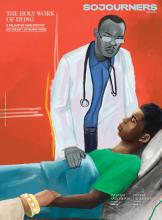I REJOICED WHEN the cicadas emerged in spring of this year. My family moved to Georgia 13 years ago, missing the periodical cicadas here by a few months. This year, trillions of cicadas from two different broods emerged across 17 U.S. states. It was the first time since 1803 that those broods’ 17- and 13-year cycles were in sync. Some see them as nuisances or pests. I marvel at them. Before this year, I hadn’t heard the distinct song of Magicicada trecidem, a member of the Great Southern Brood whose droning wail prompted worried citizens in South Carolina to call the police on male cicadas for their lovesick racket. Some days I heard the constant blare as a lament for all the wickedness in the world; other times I took it as a call to prayer. Maybe that is what prayer is: bemoaning the horrors and tuning into a God who cares about everything from nations to Magicicada—and listening to a God who cries with us.
Read the Full Article

